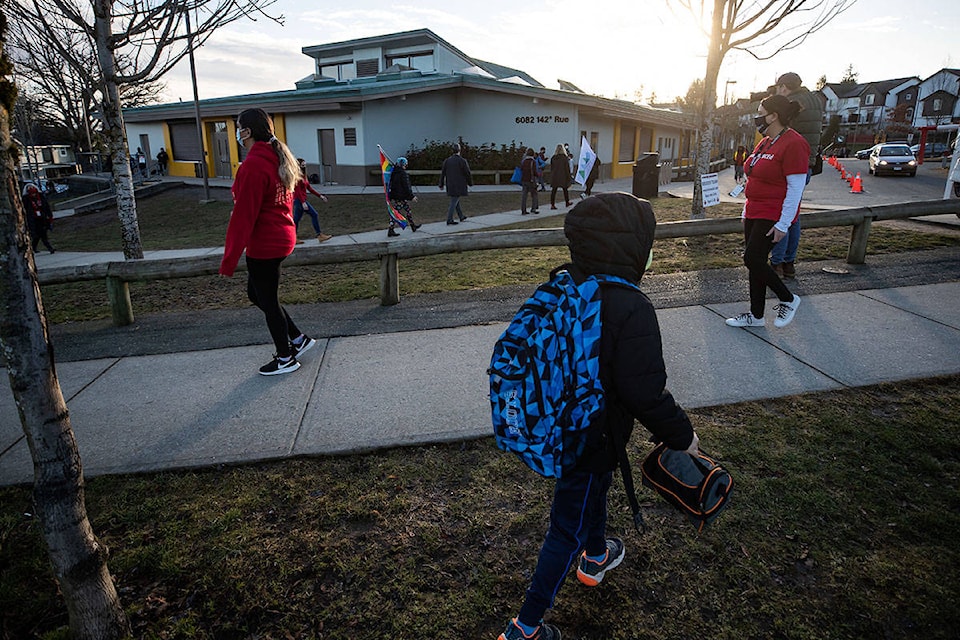The B.C. Teachers’ Federation is repeating its call for clarity as the third wave of the COVID pandemic surges to record highs.
President Teri Mooring told Black Press Media Tuesday (April 6) that K-12 schools are currently in stage 2 of the pandemic framework and have been there since September. Stage 1 would be a full return to normal while stage 5 is full scale remote learning. Stage 2 is learning groups and full-time in-class instruction.
“There needs to be clarity on what the criteria is to move from stage to stage,” Mooring said. “And that needs to be made clear to not only educators but also families.”
Mooring would also like to see a regional, municipal or even school level response where differently affected areas can make individual decisions about schools in their communities. In Ontario, medical health officers in Toronto and Peel used their authority to shut down schools for a two-week period, citing extremely high COVID risk.
Toronto’s positivity rate is at 8.4 per cent and Peel’s is at 9.6 per cent. B.C.’s 7-day positivity rate is now at 10.2 per cent, and worse in some regions; Northern Health is at 14.3 per cent while Fraser Health is at 12 per cent.
A more targeted approach, Mooring said would allow schools to shut down “when we’re seeing high levels of community transmission and we’re seeing a high number of school exposure notifications to be able to go to a hybrid model… or online.”
Mooring said that while the BCTF is not alerted directly every time students are told to self-isolated, the union remains “very concerned” due to not only the high case counts but the increasing number of variants. B.C. has seen several days of more than 1,000 cases in the past week and the total number of variants of concern has risen to 3,766, with 207 new ones confirmed on Tuesday.
“We think the system ought to be responsive and there ought to be more transparency in how decisions are made,” she said. “That’s what we’ve been lacking for a while now and we’re still lacking it.”
B.C. does not publicly share the number of schoolchildren infected with COVID-19. However, by age, there have been 5,078 children under the age of 10 infected so far during the pandemic, and 10,518 youths aged 10 to 19 infected. As of late March, kids under 10 and youths ages 10 to 19 make up five and 10 per cent of total cases, respectively. Each age group makes up one per cent of hospitalizations and less than one per cent of ICU admissions, along with zero per cent of deaths.
Mooring said that teachers want the full scope of school infections to be made public. Otherwise, Mooring said that the union is stuck finding out about situations like Surrey’s Frank Hurt Secondary, where six classes are isolating, from the teachers or in the media. While Fraser Health does publicize school exposures, the entry for Frank Hurt only lists the exposure dates, not the scale of the issue.
“We’re starting to hear increasingly from families that they don’t have enough information to decide whether they want to keep their kids in school,” Mooring said.
READ MORE: Parents struggle to navigate in-person school, child care amid B.C.’s surging 3rd wave
However, at Tuesday’s COVID-19 press briefing, provincial health officer Dr. Bonnie Henry pushed back at the idea that schools are not safe places for kids.
“We know that cases go up when children are not in school and the downside impact on families is immense,” Henry said.
“So we need to find that way of keeping children in schools so we can protect our communities and that is something we take very seriously.”
Henry said that Surrey, where the risk is highest, has adapted, citing that teachers there have received their first dose of the COVID vaccine.
But Mooring said that the province needs to get proactive, rather than remaining reactive.
“In a situation like Frank Hurt, maybe there does need to be other measures taken – especially when it’s a school where there have been continuous exposure notifications,” she said.
“There seems to be a reluctance to do that and it’s unfortunate.”
Mooring said that while she appreciates the new mask policy, the union would like to see rapid testing and an increase in ventilation as well, while teachers and students remain in school.
Like us on Facebook and follow us on Twitter.
Want to support local journalism during the pandemic? Make a donation here.
